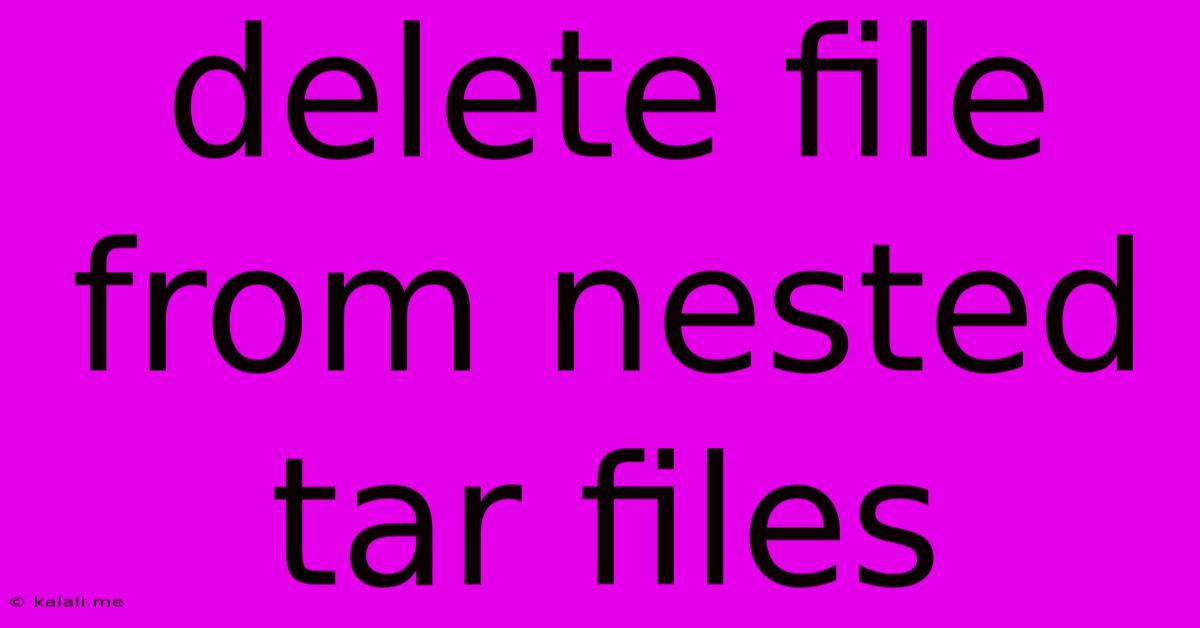Delete File From Nested Tar Files
Kalali
May 26, 2025 · 3 min read

Table of Contents
Deleting Files from Nested TAR Archives: A Comprehensive Guide
Deleting a specific file from within a deeply nested TAR archive can feel like navigating a digital labyrinth. This guide provides a clear, step-by-step approach using command-line tools, ensuring you efficiently remove the target file without corrupting the archive. This process is crucial for managing large datasets, cleaning up outdated information, and maintaining a well-organized digital environment. Understanding this technique is valuable for system administrators, data scientists, and anyone working with large compressed archives.
Understanding the Challenge: Unlike simple TAR files, nested TAR archives contain multiple TAR files within each other. This layered structure adds complexity when targeting a specific file for deletion. Simply unpacking the archive and deleting the file isn't efficient, especially with large files or complex nesting. We need a method that directly addresses the file within its nested location.
Method 1: Using tar with --delete (Most Efficient)
The tar command, a powerful archiving utility available on most Unix-like systems (including Linux and macOS), offers a streamlined solution. Its --delete option allows precise file removal from within even deeply nested archives.
Steps:
-
Identify the file path: Determine the complete path to the file you wish to delete within the TAR archive. This is crucial. For example, if the file is
my_document.txtinside a folderdocumentswithin the archivearchive.tar, the path would bedocuments/my_document.txt. -
Execute the command: Use the following command structure, replacing placeholders with your actual file path and archive name:
tar --delete --file=archive.tar documents/my_document.txt -
Verification: After executing the command, it's essential to verify the deletion. You can create a new TAR archive (if necessary) or inspect the existing one using a tool like
tar -tvf archive.tarto confirm the file is no longer present.
Method 2: Extracting, Deleting, and Re-Archiving (Less Efficient, More Resource Intensive)
This method involves extracting the archive, deleting the file, and re-archiving the contents. While less efficient than the --delete method, it's useful for understanding the underlying process and offers more control in cases with complex directory structures.
Steps:
-
Extract the archive: Use the
tarcommand to extract the contents of the archive to a temporary directory. For example:tar -xf archive.tar -C /tmp/temp_archive -
Delete the file: Navigate to the temporary directory and use the
rmcommand to delete the target file:cd /tmp/temp_archive rm -rf documents/my_document.txt -
Re-archive the contents: Create a new TAR archive from the modified contents of the temporary directory:
tar -cf new_archive.tar -C /tmp/temp_archive . -
Clean up: Remove the temporary directory:
rm -rf /tmp/temp_archive
Choosing the Right Method
The tar --delete method is significantly more efficient and resource-friendly, especially for large archives. It directly modifies the archive without needing to extract and re-archive the entire contents. The second method is suitable for situations requiring more granular control or when working with complex directory structures where understanding the file structure is essential before proceeding.
Important Considerations:
- Backup: Always create a backup of your TAR archive before performing any deletion operations. This precaution safeguards your data against accidental loss.
- File Paths: Double-check the file paths within the TAR archive. Incorrect paths can lead to unintended file deletions.
- Permissions: Ensure you have the necessary permissions to modify the TAR archive.
By mastering these techniques, you can effectively manage your nested TAR archives and maintain a clean, organized digital environment. Remember to always prioritize data integrity and back up your important files.
Latest Posts
Latest Posts
-
How Much Does A Water Bottle Weight
Jul 03, 2025
-
How Many Inches Is Half A Yard
Jul 03, 2025
-
How Old Are You If Your Born In 1996
Jul 03, 2025
-
How Many Water Bottles In 64 Ounces
Jul 03, 2025
-
How Many Cups Is 16 Oz Of Peanut Butter
Jul 03, 2025
Related Post
Thank you for visiting our website which covers about Delete File From Nested Tar Files . We hope the information provided has been useful to you. Feel free to contact us if you have any questions or need further assistance. See you next time and don't miss to bookmark.